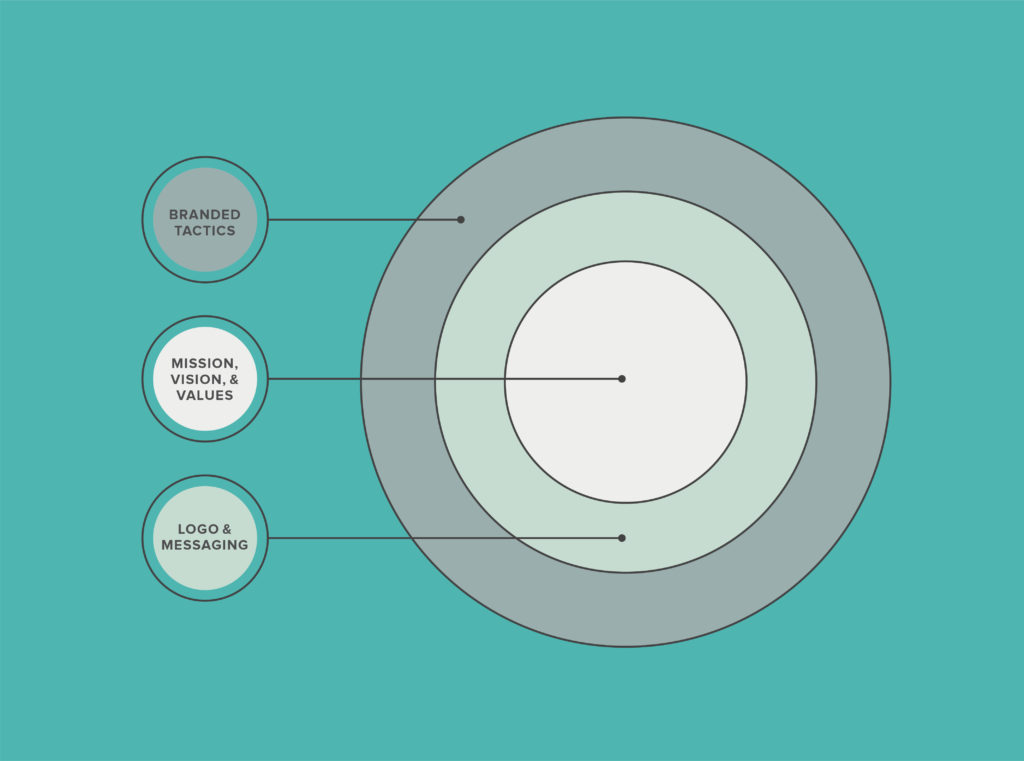As a lifelong designer, it pains me to admit that the logos I create don’t compel swarms of people to take action. But it’s true. Logos are just the superficial face of a more necessary brand core.
When I hear a client say – and I hear it often – “we need a new logo,” I usually agree. Then, I keep digging.
99% of the time, the call for a “new logo” is actually a call for something else, a signal to some deeper business problem within an organization that needs to be uncovered. Maybe there’s a lack of internal alignment, rising frustration with dated marketing, or a new strategic directive to follow. But almost always, our clients’ “logo” issue is actually a harbinger of something else entirely. So I must confess, as much as it hurts my creative director soul, your logo is not that important–at least not in the way you’re probably thinking. Where this conversation should begin is at your brand.
What is the difference between a logo and a brand?
The terms “logo” and “brand” are often used interchangeably. In reality, a logo is only a single, albeit highly visible, element of your brand. It’s a lot like holding up a single puzzle piece and trying to visualize the entire finished picture.
Let’s clear the air: A logo is a visual mark that represents your brand.
A brand is who your company is and what it stands for. The basic principles of branding include your tagline, mission, vision, values, story, voice, tone, and logo mark – essentially, everything that guides internal decisions and informs external perceptions.
Nobody cares that the Trader Joe’s logo features a unique, surfer-inspired typeface that uses PMS 1935 C red. They care that from their product mix to their employees, Trader Joe’s provides an overwhelmingly positive customer experience. (perhaps why they can double their competitions’ sales).
Nobody cares that the trademark Nike swoosh is stunningly simple and connotes motion as it draws the eye in a positive direction. They care that Nike supports the lifestyle they envision for themselves and pushes them to just do it, whatever that “it” is.
No one has ever purchased anything because of an exceptional logo.
Just like no one has ever married someone because of their excellent handshake (at least I hope not). However, this is not to say that your logo is some throwaway project you could hand some 5-year-old kid along with a box of crayons. It takes work. It takes strategy. It takes intention. The most effective logos are a consistent and clear reflection of an organization’s mission and values. Of course, consistency in visual expression is key, but so is consistency between written and visual brand. Sometimes, achieving this level of alignment means starting from the ground up. Other times, like in the case of Instagram’s 2016 rebrand, it’s an evolution. The social media giant’s recent rebranding stands as the most important, and controversial, in recent public memory.
With this refresh, Instagram did not change who they were and what they stood for (i.e. their “brand”). By simplifying the logo and interface design and bringing more attention to users’ content, Instagram had evolved into the next version of themselves, staying true to their vision while bringing it into modern times. Their corporate values of Community First, Inspire Creativity, and Simplicity Matters are self evident in the new logo mark design alone.
Plus, Instagram’s subsequent benchmark of 1 billion active monthly users in 2018 is hard to argue with. Your logo is often the most widely seen representation of your brand. Knowing this, how can you expect to develop an effective logo without first defining the foundation of your brand strategy? When considering how to rebrand your business, give yourself time to take a step back.
The transformative power of a logo redesign is in the process, not just the result.
Pardon my cliche, but it’s true. As an agency, if we work with only a single member from our clients’ team during a rebranding process, it’s not because we asked for it. This process usually involves a group of individual stakeholders in the organization who care about the brand, are passionate about its success, and who want to provide input to make it better. And we love that.
The involvement, or lack thereof, of key stakeholders during a rebrand process is maybe the biggest predictor we see of a brand’s longevity and future success. So much of rebranding is about achieving internal alignment within an organization. During this process, you’ll work to find shared answers to the questions which define your business or nonprofit:
- Who are we?
- What do we do?
- What do we stand for?
- Why do we exist?
- What makes us different?
So, as an outgrowth of this new brand definition, your logo becomes a monument to the work that has been done by your organization’s stakeholders to chart the path for your organization. Not to mention, designing the logo is undeniably the most fun part of the process – but I may be biased.

So, what are some tips for rebranding your organization?
Glad you asked. Here are just a few things I’ve learned from leading this process across several industries, clients, and years.
Know What You’re Working Towards
In other words, know why you’re rebranding in the first place. The most common brand elements include defining your brand architecture, mission statement, vision statement, values, tagline, voice & tone guidelines, and visual identity guidelines. But if you don’t understand why you’re striving to check these boxes, you’re missing out on half of the benefit.
This blog post on the principles of branding and brand strategy will give you a deeper look at the process.

Investigate where your competition stands, but don’t fall prey to accidental emulation
One necessary component of any brand refresh is a competitive review. Understanding where your competitors stand in the market and how they promote themselves can help you identify different levers to pull for your own brand.
However, it’s common to find a competitor who is doing well and wish to nearly duplicate their strategy for your own. Resist the urge! Start with what makes your brand unique first. There may be some overlap when pen meets paper, but the goal is to be able to clearly communicate what makes your brand different.
Get stakeholders involved
What do I mean by stakeholders? These could be members of your internal team (e.g. executive team, marketing team, board of directors, etc.), and even people outside of your team (e.g. former, current, and potential customers). Start by having conversations with them about your brand. What is working? What is not? What need does your brand solve that others do not?
Eventually, after working through the crucial elements of your brand strategy, you will be ready to address your logo. Working with a designer to develop a logo your whole team can feel proud of is worth it. While the mark itself may not sway your audiences’ decisions, the confidence you exude through your logo as a representation of your brand just might.
Time for a rebrand? We'd love to help.
Contact UsRecent Insights
A Strategic Brand is Essential for Nonprofit Marketing Success
An authentic brand is what your audience thinks of you. But without marketing, how does your audience know you even exist?
28
Jan

28
Jan
How to Name (or Rename) a Brand
How do you choose a good brand name? And once you've come up with one, how do you know if it'll be successful? These questions sound daunting until you add them into the right context. So, to understand the nuances of naming a brand, let's start from the top.
15
Jan

15
Jan
The Benefits of Working with a Midsize Creative Agency
Discover the strategic advantages of partnering with a midsize agency like Push10, where personalized attention, agility, diverse talent, intentional size management, cost-effective solutions, and consistent quality converge to propel your branding and website design projects towards success.
15
Nov

15
Nov
